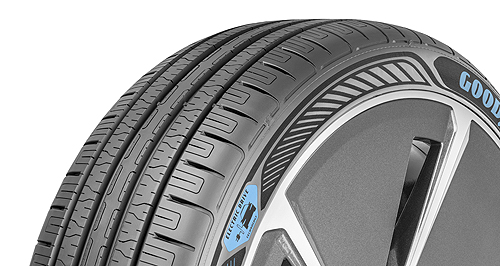Make / Model Search
News - General News - TechnologyGeneva show: Goodyear rolls out EV and urban tyresThey see me rolling: The Oxygene absorbs moisture from the road and inhales carbon dioxide from the air to feed the living moss that grows within its sidewall, resulting in oxygen being released. Goodyear’s EfficientGrip Performance and Oxygene tyres target emerging segmentsGallery Click to see larger images 8 Mar 2018 WHILE the halls of this week’s Geneva motor show were brimmed with electric vehicles and urban models, Goodyear made its move on the increasingly popular segments with the reveal of the EfficientGrip Performance and Oxygene concept tyres. Shown in prototype form, the EfficientGrip Performance features the American tyre-maker’s Electric Drive Technology that attempts to combat some of the issues EVs face, according to Goodyear Europe, Middle East and Africa president Chris Delaney. “The combination of increasing regulations to reduce emissions, the desire to reduce dependence on fossil fuels and rapid gains in battery technology is creating an ideal environment for electric vehicles,” he said. “We are working with auto-makers to introduce our Electric Drive Technology next year, designed to address the unique performance requirements of this growing vehicle segment. “As a company with a 120-year heritage of delivering innovative products that help change the world of transport, the EfficientGrip Performance prototype with Electric Drive Technology is proof that Goodyear continues to lead on this path of future mobility.” Specifically, the tread of this tyre has thinner sipes that create a larger rubber contact patch on the road surface when compared with traditional radial grooves. This change is critical as regular tyres wear out up to 30 per cent faster on EVs due to the high levels of instantaneous torque from their electric motors. Furthermore, high performance in wet conditions is maintained with this design that also prevents sound waves from entering its grooves, helping to reduce tyre noise – key as EVs at low speed produce at least half the sound of traditional vehicles. Another reason for shorter tyre life is the extra weight EVs carry from their heavy battery packs, with Goodyear optimising the EfficientGrip Performance’s cavity shape to support the additional heft while maintaining an optimal tread footprint for high performance. The material properties of the tread compound have been tweaked for ultra-low rolling resistance to extend EV range, while the redesigned sidewall decreases aerodynamic drag and the profile returns less rotating mass, resulting in improved energy consumption. These innovations are particularly important in countries, such as Australia, where EV charging infrastructure is underdeveloped. Meanwhile, research from the World Health Organisation (WHO) shows that more than 80 per cent of people living in air pollution-measured urban areas are exposed to air quality levels that exceed WHO limits, with the Oxygene set to play its part in correcting this, Mr Delaney explained. “With more than two-thirds of the world population expected to live in cities by 2050, the demands on transport networks in urban environments will increase substantially,” he said. “Smarter, greener infrastructure and transport will be crucial in addressing the most pressing challenges of urban mobility and development. “Like the concept designs Goodyear has presented at Geneva in the past, Oxygene is meant to challenge our thinking and help drive the debate around smart, safe and sustainable future mobility. “By contributing in this way to a cleaner air generation, the tyre could help enhance quality of life and health for city-dwellers.” The Oxygene absorbs moisture from the road via its unique tread design – improving wet grip – and inhales carbon dioxide from the air to feed the living moss that grows within its sidewall, resulting in the release of oxygen through photosynthesis. According to Goodyear, in a city with about 2.5 million vehicles, such as greater Paris, nearly 3000 tonnes of oxygen would be generated and more than 4000 tonnes of carbon dioxide would be absorbed per year if the Oxygene was rolled out. In keeping with its environmentally friendly nature, the Oxygene has a non-pneumatic construction that is 3D-printed with rubber powder from recycled tyres. “The lightweight, shock-absorbing structure provides a long-lasting, puncture-free solution intended to extend the life of the tyre and minimize service issues, delivering worry-free mobility,” Goodyear added. Additionally, the Oxygene harvests the energy created during photosynthesis to power its embedded electronics that include on-board sensors, an artificial intelligence processing unit and a light strip in the sidewall. The latter is customisable and can switch colours to warn both road users and pedestrians of upcoming vehicle manoeuvres, such as lane changes or braking. A visible light communications system, dubbed LiFi, enables high-capacity mobile connectivity at an instant, allowing vehicle-to-vehicle and vehicle-to-infrastructure data exchange that is required for smart mobility management. Exactly when the Oxygene will go into production remains unknown, but European buyers can expect to see the EfficientGrip Performance hitting roads in 2019.  Read more8th of August 2017  Goodyear defends Eagle-360 concept tyreRadical ideas important for innovation in tyre industry, according to Goodyear7th of August 2017  Green credentials important to GoodyearNew environmentally friendly components, TSA boosts Goodyear’s green reputation4th of August 2017  Australia still important in Asia-Pacific region: GoodyearAussie input still valued at Goodyear despite juggernaut Chinese and Indian markets4th of August 2017  Goodyear developing tyres for EVs, autonomousChallenges for Goodyear as it works to produce tyres for EVs and autonomous cars |
Click to shareGeneral News articlesResearch General News Motor industry news |

















Facebook Twitter Instagram